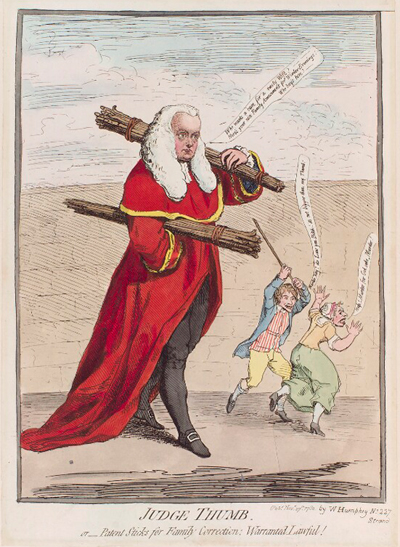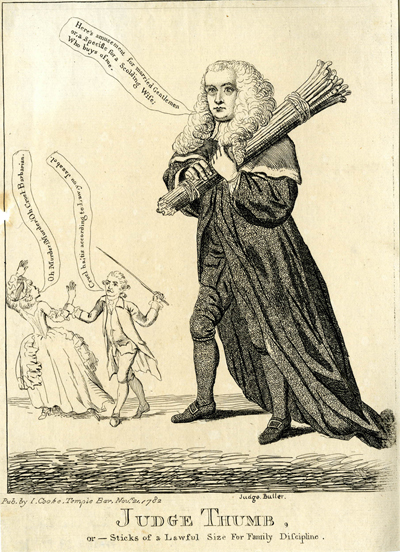Judge Thumb, or Patent Sticks for Family Correction
The starting point for this print may have been the following paragraph that appeared in the Morning Herald and Daily Advertiser for September 18, 1782, p. 3.
At the last assizes at W____, a man was tried for having beat his wife so that she was supposed to die of the contusions and bruises. The prisoner was allowed counsel, and in defence of the man it was alledged, that a husband had a legal power of chastising his wife. The Judge objected to the pertinence of the allegation because the prisoner had used a faggot. It is allowed that a husband may correct his wife but not with a faggot. The Counsel asked what size the stick should be, which might be so applied? He gravely put out his hand, and said, "Of the size of my thumb." All the ladies in W____ sent messages to his lodgings to obtain the exact measure of his Lordship's thumb; and the lawyers have given their opinion that if a husband should use a stick, differing in dimensions by the breadth of a hair from Judge _____'s thumb, an action will lie, and heavy damages be recoverable by the wife!

© National Portrait Gallery, London
There is, of course, no name attached to the presiding judge in the Morning Herald article. But in the "Answers to Correspondents" section of The European Magazine and London Review for November 1, 1782, the question of whether a man may lawfully correct his wife is answered as "settled by Judge B_____." And indeed contemporary notations on Gillray's and other related prints consistently identify the anonymous "Judge Thumb" as Sir Francis Buller.
The story is also consistent with his reputation. Buller was a precocious student of the law. He was called to the bar in 1772 at the age of 26 and by the time he was 32 he had become the youngest member of the King's Bench. Though recognized for his "clearness of statement and his quickness in seizing the points of the contending counsel," he was (not surprisingly) arrogant and hasty in his opinions—precisely the sort of man to make such an off the cuff remark from the bench.
In any case, the story soon prompted at least three caricatures: Judge thumb, or-sticks of a lawful size for family discipline listed as published on November 21st by I. Cooke, Temple Bar; Judge Thumb, or-patent sticks for family correction: warranted lawful! (our Gillray print) listed as published initially by Elizabeth D'Achery on November 27th, but also published with the same date by William Humphrey; and, finally, Mr. Justice Thumb in the act of flagellation which seems to have been published for sheer titillation supposedly appearing (though I have not verified this) in The Rambler's Magazine in January 1783. That magazine seems like it would have been an ideal vehicle for the print since it is fulsomely subtitled as The annals of gallantry, glee, pleasure, and the bon ton; calculated for the entertainment of the polite world; and to furnish the man of pleasure with a most delicious banquet of amorous, Bacchanalian, whimsical, humorous, theatrical and polite entertainment.
The publisher of the first print, I. Cooke, Temple Bar is either a very small time or fictitious printseller. There are no other prints by that publisher in the British Museum collection or at the Lewis Walpole Library for either 1782 or 1783. And I suspect the name may be another way of announcing that the print is a roasting of the legal profession. But if we can believe the publication date, it preceded Gillray's print by approximately a week and there are so many similarities between the two prints that it is hard to believe that Gillray would not have been aware of it.

© Trustees of the British Museum
Both prints, for instance, show a non-caricatured portrait of Judge Buller at full length in robes and wig. Both show him carrying (and offering for sale!) bunches of the "lawful" thumb-like sticks bound like the traditional Roman fasces symbolizing (appropriately) penal power. Both show a husband in the background using a stick to beat his protesting wife while claiming that his brutality is now lawful.
The differences between the prints are minor in comparison to these broad similarities. In one, Buller faces left; in the other, he faces right. In one, he carries a single bundle of sticks like a Roman lictor; in the other, two bundles. And in one, the background figures appear to be a gentleman and lady; in the other, members of a lower class.
There are many unknowns here. After all, none of the three prints is signed. And publication dates were sometimes fudged to create the appearance of priority. So we can't say for sure that the November 21st print was really published on that date. What makes the November 27th print more likely to be a Gillray is that it was published by Elizabeth D'Achery and William Humphrey both of whom were regular publishers of Gillray in 1782, and that the print has been generally accepted as a Gillray by Thomas Wright and Joseph Grego, and included as a Gillray in major collections such as the British Museum.
So who created the the other print which resembles Gillray's in so many ways? And did it really appear first? Did Gillray, like many other caricaturists of his day, simply "borrow" most of the ideas from the earlier print, making a few minor changes, perhaps, to salve his conscience? We will likely never known for sure. But let me propose a theory based upon what we do know. First, Gillray seldom copied from another artist. He generally had too much pride for that. But he does sometimes copy from himself (as he did earlier in 1782 with prints on Lady Worsley published by Brown and Humphrey). Second, in 1782 he worked for ten different printsellers, including at least one, P.J. Leatherhead that was probably fictional. Third, the level of print-making expertise in the November 21st print is roughly equivalent to Gillray's.
With those three points in mind, here is what I think happened. In response to the general notice of Judge Buller's pronouncement, Gillray designed and published the first print, Judge thumb, or-sticks of a lawful size for family discipline on November 21st using either a small or fictional printseller. He may have had second thoughts about the awkward-looking arms and class of the background husband. After all, the purchasers of prints would have had a greater tolerance for the depiction of wife beating when it was relegated to the lower classes. So he produced the second print, Judge Thumb, or Patent Sticks for Family Correction. . . with Elizabeth D'Achery on November 27th making sufficient changes to satisfy himself that each print could stand alone. But as time went on and more and more of Gillray's work went to the Humphreys, so the same print, using the same date, was issued by W. Humphrey some time between 1782 and 1784.
Sources and Reading
- Commentary from the British Museum on Judge Thumb, or Patent Sticks for Family Correction. . ..
- "Sir Francis Buller, 1st Baronet," Wikipedia
- Henry Ansgar Kelly, "'Rule of Thumb' and the Folklaw of the Husband's Stick" Journal of Legal Education Vol. 44, No 3, pp. 341-365.
- Thomas Wright and R.H. Evans, Historical and Descriptive Account of the Caricatures of James Gillray #13
- Thomas Wright and Joseph Grego, The Works of James Gillray, the Caricaturist; With the History of His Life and Times pp.43-44.
Comments & Corrections
NOTE: Comments and/or corrections are always appreciated. To make that easier, I have included a form below that you can use. I promise never to share any of the info provided without your express permission.